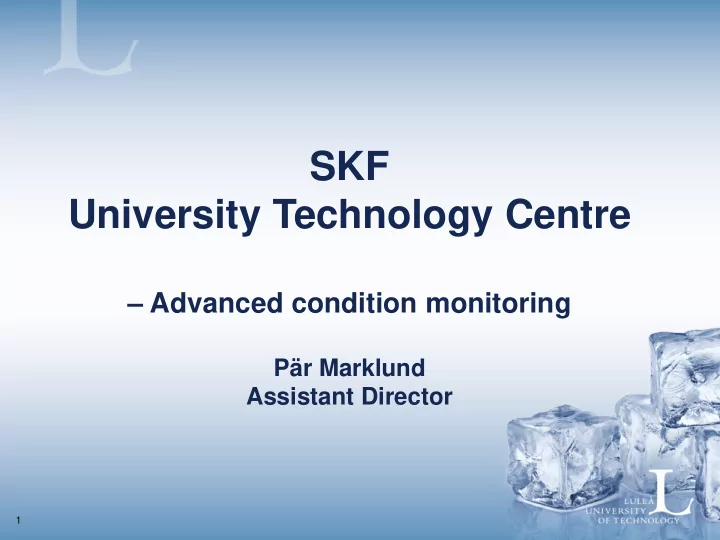

SKF University Technology Centre – Advanced condition monitoring Pär Marklund Assistant Director 1
SKF University Technology Centre – Visions and trends 2
Vision: The Smart bearing Communicating wireless with its environment and manage its own energy supply I’m running at 1434 rpm I need more grease! I’m 75ºC and I’m hot! The load is 455 N I’m unaligned My Remaining Useful Life is 372119 revolutions I feel fine but you’d better check the rest of the machine 3
Smart bearings will open for new services connected to the bearing and its generated data Remote diagnostics Planning of service Prognosis Statistics Safety and reliability 4
3 big ideas to build one smarter asset Instrument the assets A billion transistors per human being on the planet Interconnect them A trillion devices all giving off data – the ‘internet of things’ Make them intelligent New analytics tools assessing this ocean of data 5
Bearings are parts of all machines ⇒ A smart bearing will be the brain of the machine! The bearing will be a sensor for the whole machine! 6
A Smart bearing is so much more than just a bearing! Operation Error detection Detect wheel damage planning of bearing Position of the car Error detection in boggie Load in the car Maintenance planning Detect rail damage Continuous scanning of rail 7
Example: Where are we today? Electrified car Vibration Wires are possible Rpm Power is available Temperature 8
What about cargo trains? Often not electrified cars • Wires ”are not possible” ⇒ Wireless communication ⇒ Power harvesting • Power is not available 9
What about cargo trains? Future scenario! Imagine a future bearing in the last car without electricity that through wireless communication has to notify the driver that: “I’m running hot and would like you to reduce the speed with 20 km/h” ”Ok. Let me know if I have to slow down even more.” ”Ok” “Will do! I also borrowed the trains communication system to notify the service personel that I have to be replaced. They said I have to be delivered to the workshop in Luleå tomorrow. With the current reduced speed I will survive the whole way.” 10
Different types of maintenance… Error based Mileage based Time based Condition based = Condition Monitoring Error indicators • Vibrations • Temperature change Tribological indicators • Viscosity change • Particles in lubricant • Additive consumtion • Acoustic emission 11
UTC Architecture 12
UTC Architecture • The projects in the UTC should together cover the whole UTC architecture. • This means that: – The whole system from bearing to data management and business will be covered. – The function of the bearing will change from a machine component to a integrated sensor. – New knowledge will be created about e.g. • sensor technology, • signal processing • robust /durable electronics • data management and decision support systems. 13
SKF EISLAB Other companies (Internet of Things, and organisations System of systems, (e.g. Trafikverket, LKAB, sensors, embedded Bosch Rexroth, Scania, systems, electronics, Vattenfall, Ericsson) communication ) SKF UTC @ LTU Operation and Maintenance Engineering (Maintenance strategies, reliability, integration with management systems) External funding (E.g. VINNOVA, VR, Machine Elements Wallenberg, SSF, … ) (tribology, mechanical engineering, measurement strategies, diagnostics) Students (Undergraduate and PhD student projects) 14
Where do we start? • Startup projects: – 6 PhD students will now be employed for the first six projects within the UTC • 2: Machine Elements (Sensor Techniques) • 2: Eislab (Signal processing and electronics) • 2: Operation and Maintenance Engineering (Models for decision support) • Research projects are a combination of: – Continuation of research areas where SKF have previous experience. – “New” research areas. • Research environment – Different divisions work together 15
Thank you! 16
Recommend
More recommend